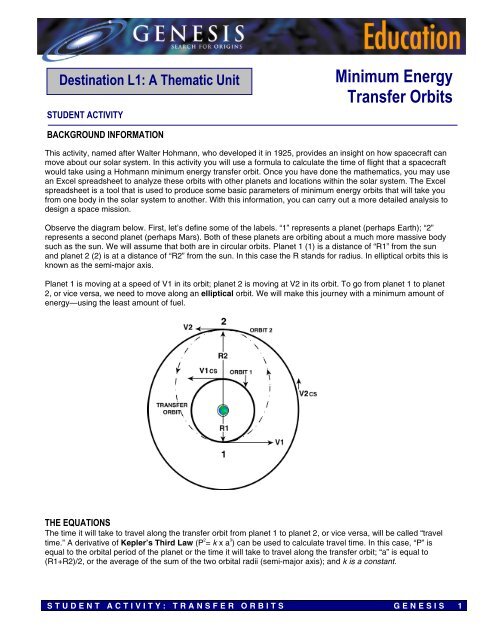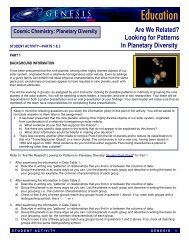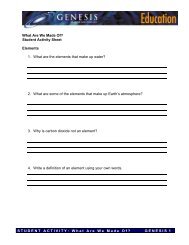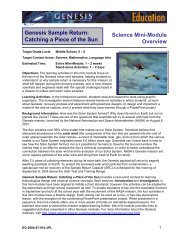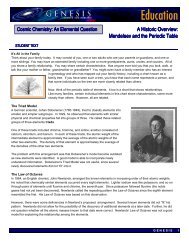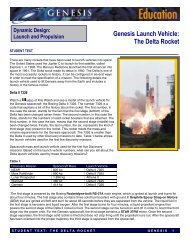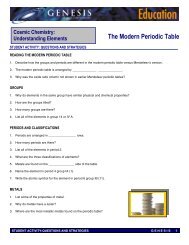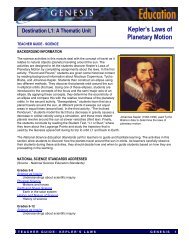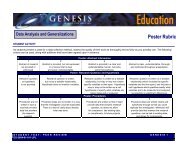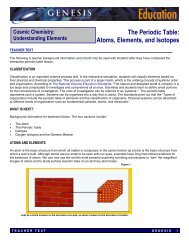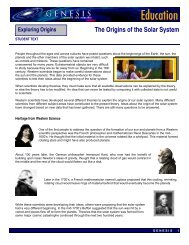A Thematic Unit Minimum Energy Transfer Orbits - Genesis
A Thematic Unit Minimum Energy Transfer Orbits - Genesis
A Thematic Unit Minimum Energy Transfer Orbits - Genesis
You also want an ePaper? Increase the reach of your titles
YUMPU automatically turns print PDFs into web optimized ePapers that Google loves.
Destination L1: A <strong>Thematic</strong> <strong>Unit</strong><br />
STUDENT ACTIVITY<br />
BACKGROUND INFORMATION<br />
<strong>Minimum</strong> <strong>Energy</strong><br />
<strong>Transfer</strong> <strong>Orbits</strong><br />
This activity, named after Walter Hohmann, who developed it in 1925, provides an insight on how spacecraft can<br />
move about our solar system. In this activity you will use a formula to calculate the time of flight that a spacecraft<br />
would take using a Hohmann minimum energy transfer orbit. Once you have done the mathematics, you may use<br />
an Excel spreadsheet to analyze these orbits with other planets and locations within the solar system. The Excel<br />
spreadsheet is a tool that is used to produce some basic parameters of minimum energy orbits that will take you<br />
from one body in the solar system to another. With this information, you can carry out a more detailed analysis to<br />
design a space mission.<br />
Observe the diagram below. First, let’s define some of the labels. “1” represents a planet (perhaps Earth); “2”<br />
represents a second planet (perhaps Mars). Both of these planets are orbiting about a much more massive body<br />
such as the sun. We will assume that both are in circular orbits. Planet 1 (1) is a distance of “R1” from the sun<br />
and planet 2 (2) is at a distance of “R2” from the sun. In this case the R stands for radius. In elliptical orbits this is<br />
known as the semi-major axis.<br />
Planet 1 is moving at a speed of V1 in its orbit; planet 2 is moving at V2 in its orbit. To go from planet 1 to planet<br />
2, or vice versa, we need to move along an elliptical orbit. We will make this journey with a minimum amount of<br />
energy—using the least amount of fuel.<br />
THE EQUATIONS<br />
The time it will take to travel along the transfer orbit from planet 1 to planet 2, or vice versa, will be called “travel<br />
3<br />
time.” A derivative of Kepler’s Third Law (P 2 = k x a ) can be used to calculate travel time. In this case, “P” is<br />
equal to the orbital period of the planet or the time it will take to travel along the transfer orbit; “a” is equal to<br />
(R1+R2)/2, or the average of the sum of the two orbital radii (semi-major axis); and k is a constant.<br />
STUDENT ACTIVITY: TRANSFER ORBITS GENESIS<br />
1
First, let’s find the average sum of the two orbital radii of Earth and Mars.<br />
a = (R1+R2)/2<br />
a = distance of sun to Earth + distance of sun to Mars divided by 2<br />
a = (1.000 AU + 1.524 AU)/2<br />
a = 1.262 AU<br />
Next, we will use the “a” value to find the time of flight from Earth to Mars using a Hohmann minimum energy<br />
transfer orbit. Remember “P” squared in years is proportional to “a” cubed measured in AU. Using Kepler’s Third<br />
Law, Walter Hohmann determined the formula for calculating transfer orbits for circular orbits. We divide by 1 AU<br />
because this represents the circular radius of Earth’s orbit. k is equal to 0.5 when the unit for time is in years and<br />
the unit for distance is AU.<br />
P2 = k x a 3 AU/1 AU<br />
P = k x a 3/2 AU/1 AU<br />
P = 0.5 (1.262 AU) 3/2 AU/1 AU<br />
P = 0.709 years<br />
TABLE OF PERIODS FOR ORBITS OF SOME BODIES IN SPACE<br />
Body Average Distance from the Sun (AU) Average Distance from the Sun (k<br />
Body Average Distance from the Sun (AU) Average Distance from the Sun (km)<br />
Mercury 0.387 5,790,758<br />
Venus 0.723 10,818,394<br />
Earth 1.000 149,632,000<br />
Mars 1.524 227,988,770<br />
Jupiter 5.203 778,496,460<br />
Saturn 9.555 1,429,705,900<br />
Uranus 19.191 2,871,604,300<br />
Neptune 48.445 7,248,969,300<br />
Pluto<br />
Other<br />
39.530 5,914,952,960<br />
Use the equations and table above to find the travel time using a Hohmann minimum transfer orbit for a trip from<br />
Earth to Venus. Use the space provided below to show your work.<br />
STUDE NT ACTI V ITY: TRAN SFER O RBITS G E NE SIS<br />
2
TECHNOLOGY APPLICATION:<br />
Use the following information to find the Hohmann minimum transfer orbits from the Earth to other places in the<br />
solar system. The following is how to use a pre-programmed Excel spreadsheet.<br />
1. Open up the workbook (you can double click the file name of Hohmann.xls). The first column gives the<br />
names of the planets. The last row has the name “other.” This is to allow one to experiment in transferring to<br />
some location other than a planet, e.g., an asteroid; however, you will have to find out the bodies’ average<br />
distance from the sun. The second column gives the average distance from the sun in “Astronomical <strong>Unit</strong>s,”<br />
(AUs). This unit of measure is one average distance of the Earth from the sun, as illustrated by Earth with a<br />
distance in AUs of 1.000. The third column gives this distance in kilometers.<br />
2. Investigate the transfer orbits from Earth to all the other planets. To do this, take the value of the distance<br />
from the sun for the Earth from column three, 149,632,000 km. Enter this number into the first row of column<br />
four (D) “R1-Start Dist. From Sun.”<br />
3. Now, use the pull down menu of “Tools,” then “Macro,” and then “Macros.” The macro window will come up<br />
with “Hohmann” highlighted. Click “Run.” The rest of the spreadsheet will fill in using the equations shown<br />
above. (You can look at the macro by using “Edit” to see the listing and how the equations are solved.)<br />
The headings of the columns are self-explanatory, but to be sure Column 9 (I) “R1 Body Orb. Vel (km/sec)” is<br />
the velocity in its orbit of the body we are leaving from—in this case, the Earth. Column 10 (J), “2 nd Body Orb.<br />
Vel (km/sec) shows the velocity of all the other bodies in their orbits. Column 12 (L), “1. Orbit Trans. Vel<br />
(km/sec),” is the velocity you must get your spacecraft to obtain to get you traveling along the transfer orbit. If<br />
you want to get to a body closer to the sun than Earth, you actually slow down from the orbit speed. To get to<br />
a body farther out than your starting point, you must add to the orbital velocity. Column 14 (N), “2. Orbit Trans<br />
Vel (km/sec)” is the velocity your spacecraft will be going as it moves along the elliptical transfer orbit when it<br />
gets to the spot in space that meets the path of the circular orbit of the body you are traveling to. Compare<br />
this to the number in Column 10 to see what you need to do with your spacecraft to transfer into the orbit of<br />
the 2 nd body. You must either increase or decrease your spacecraft velocity just as you are tangential to the<br />
orbit of the 2 nd body to match its speed in its circular orbit.<br />
Columns 16 (P), 17 (Q), and 18 (R) give you the time of flight from the starting body to the second body in<br />
different units (sec, days, and years).<br />
The data for the Earth-to-Earth do not really seem to make sense until you realize what you are doing is<br />
positioning yourself 180 degrees from where you are around the sun. It will take one half an Earth-year to do this.<br />
4. Use the spreadsheet that has the transfer orbits from Earth to all the other planets that you created above to<br />
answer the questions on the student reporting sheet.<br />
A FINAL IMPORTANT NOTE<br />
The actual “mission planning” done by the “space navigators” must be much more exact and accurate than the<br />
simple model we have used. The planets are not exactly in circular orbits; we often move along a transfer orbit<br />
that is not minimum energy; we often decide what day we want to get to a planet because of sun conditions; and<br />
we often use “gravity assist,” etc. With all this said, our simple calculations will give you a very good estimate of<br />
the flight parameters. In comparison during the Magellan mission to Venus, these simple equations predicted the<br />
time of flight within several days.<br />
STUDENT ACTIVITY: TRANSFER ORBITS GENESIS<br />
3
EXTENSION ACTIVITIES<br />
• Experiment starting your transfer orbit from Mars, Venus, Mercury, and all the other planets. Does the travel<br />
time (T) match what you expected?<br />
• Look up the orbit of an asteroid (you will need to assume it is a circular orbit). See how long it w ill take to get to<br />
it from Earth.<br />
• Your spreadsheet will give you the time it takes to get to the orbit of the body you are traveling to, but will the<br />
body be there when you get there? You are aiming at a “moving target.” When you launch, the second body<br />
must be in a location such that it w ill take the travel time period to the point of intersection. That way it will be<br />
there when you are. How can you calculate the positions of the two bodies when you launch? Here is one<br />
simple, “first principles” approach.<br />
i i<br />
li i ∏ R 2 1. Use the information in Column 3 (C) to calculate the c rcumference of the second orb t of body 2,<br />
the body you are trave ng to (remember c rcumference = ).<br />
2. Multiply the value of Column 14 (N) times the trave l time (sec) given in column 16 (P) (remember<br />
distance = rate X time). This will give you the distance in kilometers; the second body will travel<br />
along its orbit during the transfer from the first body to the position of the second orbit.<br />
3. For the second body to travel exactly once around the sun, it w ill sweep out an angle of 360<br />
degrees around the sun.<br />
4. Set up a fraction with the numerator the distance the second body travels during the time of flight<br />
and the denominator the circumference of the orbit of the second body.<br />
5. Multiply this fraction times 360 to see how many degrees ahead of the intersection point the second<br />
body must be when you launch.<br />
6. Body 1 w ill be at a position 180 degrees from the intersection point of the transfer orbit and the orbit<br />
of the second body.<br />
7. Look up the positions of the two bodies in the solar system to determine when you w ill be able to<br />
make this journey.<br />
8. Approximately how often can we travel from the Earth to Mars?<br />
STUDENT ACTIVITY: TRANSFER ORBITS GENESIS<br />
4


